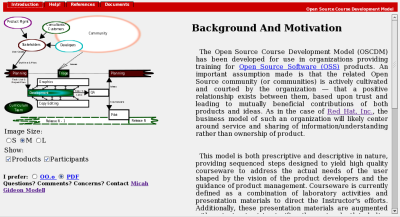History

One of the two major projects in Instructional Design & Development II was to build a Instructional Design (ID) model for use in an educational context of our choosing. My chosen context was that of the training and services arm of an Open Source software company.
What is it?
This Instructional Design Model was designed to serve the dual purpose of clearly representing the process to be used in developing training materials both as an image and in text form as well as to function as a job aid for those attempting to implement it. An important aspect of any such model is its ability to be understood at a high level in a brief glance. However, to serve as a job aid, not only does it fully describe each individual step of the process, but it also provides tools such as checklists and worksheets to be used in each phase.
The unique power of Open Source is attributed to the communities of developers, testers and evangelists which support it. This model attempts to take into account this group of people which is quite dynamic in composition. Although it is difficult to guess who will offer the most relevant input or assistance at any given moment, they cannot be overlooked and effort must be made to include them.
It was a challenge to keep track of all the moving parts of this model and insure that no skills or potential went untapped. I have been quite proud of this work product and have adapted it for work as my organisation has grown and changed. Some of the actor definitions have changed and some of the sources of work have been renamed, but largely the process has remained intact and it has provided consistent results.
How we did it
This project was developed as a self-contained web page with an image in Scalable Vector Graphics (SVG) format as the centerpiece. Asynchronous JavaScript And XML (AJAX) was used to render the image and the text in the panes around it as a single cohesive unit. The design allows for the image to be quickly and easily expanded when the user wants to focus on the big picture or shrunk down when delving into the nitty gritty details in the text.
Collaborators
- Micah Modell
Materials
Documents
Resources Used